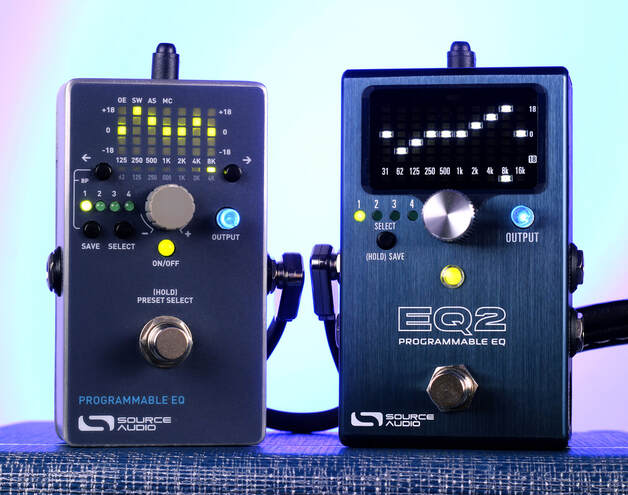EQ2: A Graphic or Parametric Equalizer?When buying an EQ pedal, chances are you’ve come across the two terms "graphic" and "parametric" being thrown around to describe a particular equalizer pedal or module. We’re hoping to set the record straight in defining these terms and help you figure out which style best suits your needs. With regards to the EQ2, which one of these is it, and why? Graphic Equalizer The EQ2 Programmable EQ starts off its life right out of the box as a simple Graphic EQ. Graphic EQs are typically 6-10 band EQs, with fixed frequency values and relatively evenly spaced bands. The filters (bands) are always in parallel. Graphic equalizers have no way of adjusting the bandwidth or frequency centerpoint of any of the bands. Typically, all you can do with a graphic EQ is slide the band up or down to boost or cut the frequency. Without entering the menu accessible on the EQ2 by holding down on the encoder knob, you’re effectively using the EQ2 as a standard Graphic EQ pedal. Likewise, the original Source Audio Programmable EQ is a Graphic EQ with four preset slots. Parametric Equalizer Parametric EQ simply refers to an equalizer with variable parameters. These parameters usually include frequency, bandwidth (Q) and a boost/cut amount. The frequency point and Q can be configured by accessing the EQ2’s onboard menu. Many parametric equalizers tend to have fewer filters to work with, since they are more powerful than their graphic counterparts. This is not the case for EQ2. On the EQ2, you will still retain control over all 10 bands for ultimate tone-sculpting. Common Parameters in a Parametric EQ Frequency: Most parametric equalizers allow you to adjust the frequency or “centerpoint” of each band in Hz. For example, the two middle bands on the EQ2’s surface are 500Hz and 1000Hz (1kHz), but with the frequency parameter, you can set them to whatever audible frequency you like, such as 700Hz and 1200Hz. Q Factor: The Q factor, also known as bandwidth, equates to how wide or narrow each frequency band is, as measured in octaves. The default setting for each band is 1 octave, but each band can be set wider than an octave or up to 10 times as narrow for very precise boosting or cutting. As you begin to explore different frequency values and Q (bandwidth) values for each band, you are making your EQ more and more parametric. For more information on the parametric options available on your EQ2 pedal, visit the EQ2 Programmable EQ User Guide. True Parametric At Source Audio, we consider a “true” parametric equalizer to be an equalizer where the bands are in series (cascading filters) instead of parallel. By default, the EQ2 is set to parallel filters, as many equalizers marketed as parametric are still in parallel. This is because in most EQ circuit designs marketed as parametric (like in amplifiers), the filters are in series, meaning that if you adjust one filter, such as the Mid frequency control, it has an effect on the Bass and Treble controls as well. The option of switching to cascading filters is available for your EQ2 per preset via the Neuro Mobile App and the Neuro Desktop Editor.
3 Comments
Dominik Otruba
8/21/2021 08:23:58 am
Kolik prosim stoji a kde je k sehnani?
Reply
2/24/2022 03:00:24 am
Thank you for sharing informative content. It means a lot to me hope you do more articles to post.
Reply
Leave a Reply. |
AuthorAll the blogs are written by the Source Audio staff. Archives
March 2023
Categories |
-
Gear
-
Effects Pedals
>
- Artifakt Lo-fi Elements
- ZIO Analog Bass Preamp + DI
- Nemesis Delay ADT
- Ventris Dual Reverb
- Collider Delay+Reverb
- EQ2 Programmable EQ
- C4 Synth
- True Spring Reverb
- Aftershock Bass Distortion
- Spectrum Intelligent Filter
- Vertigo Tremolo
- Atlas Compressor
- ZIO Analog Front End + Boost
- Mercury Flanger
- Gemini Chorus
- Lunar Phaser
- Nemesis Delay
- Ultrawave Distortion Lab
- Ultrawave Bass Distortion Lab
- L.A. Lady Overdrive
- Kingmaker Fuzz
- Accessories >
- All
- Legacy Products
-
Effects Pedals
>
- Support
- Neuro 3
- Video & Artists
- SHOP
Gear |
Neuro Presets |
Video |
© COPYRIGHT 2024. ALL RIGHTS RESERVED.


 RSS Feed
RSS Feed